8.6.1: Metamorphosed Pelitic Rocks (Metapelites)
- Page ID
- 18622
\( \newcommand{\vecs}[1]{\overset { \scriptstyle \rightharpoonup} {\mathbf{#1}} } \)
\( \newcommand{\vecd}[1]{\overset{-\!-\!\rightharpoonup}{\vphantom{a}\smash {#1}}} \)
\( \newcommand{\id}{\mathrm{id}}\) \( \newcommand{\Span}{\mathrm{span}}\)
( \newcommand{\kernel}{\mathrm{null}\,}\) \( \newcommand{\range}{\mathrm{range}\,}\)
\( \newcommand{\RealPart}{\mathrm{Re}}\) \( \newcommand{\ImaginaryPart}{\mathrm{Im}}\)
\( \newcommand{\Argument}{\mathrm{Arg}}\) \( \newcommand{\norm}[1]{\| #1 \|}\)
\( \newcommand{\inner}[2]{\langle #1, #2 \rangle}\)
\( \newcommand{\Span}{\mathrm{span}}\)
\( \newcommand{\id}{\mathrm{id}}\)
\( \newcommand{\Span}{\mathrm{span}}\)
\( \newcommand{\kernel}{\mathrm{null}\,}\)
\( \newcommand{\range}{\mathrm{range}\,}\)
\( \newcommand{\RealPart}{\mathrm{Re}}\)
\( \newcommand{\ImaginaryPart}{\mathrm{Im}}\)
\( \newcommand{\Argument}{\mathrm{Arg}}\)
\( \newcommand{\norm}[1]{\| #1 \|}\)
\( \newcommand{\inner}[2]{\langle #1, #2 \rangle}\)
\( \newcommand{\Span}{\mathrm{span}}\) \( \newcommand{\AA}{\unicode[.8,0]{x212B}}\)
\( \newcommand{\vectorA}[1]{\vec{#1}} % arrow\)
\( \newcommand{\vectorAt}[1]{\vec{\text{#1}}} % arrow\)
\( \newcommand{\vectorB}[1]{\overset { \scriptstyle \rightharpoonup} {\mathbf{#1}} } \)
\( \newcommand{\vectorC}[1]{\textbf{#1}} \)
\( \newcommand{\vectorD}[1]{\overrightarrow{#1}} \)
\( \newcommand{\vectorDt}[1]{\overrightarrow{\text{#1}}} \)
\( \newcommand{\vectE}[1]{\overset{-\!-\!\rightharpoonup}{\vphantom{a}\smash{\mathbf {#1}}}} \)
\( \newcommand{\vecs}[1]{\overset { \scriptstyle \rightharpoonup} {\mathbf{#1}} } \)
\( \newcommand{\vecd}[1]{\overset{-\!-\!\rightharpoonup}{\vphantom{a}\smash {#1}}} \)
\(\newcommand{\avec}{\mathbf a}\) \(\newcommand{\bvec}{\mathbf b}\) \(\newcommand{\cvec}{\mathbf c}\) \(\newcommand{\dvec}{\mathbf d}\) \(\newcommand{\dtil}{\widetilde{\mathbf d}}\) \(\newcommand{\evec}{\mathbf e}\) \(\newcommand{\fvec}{\mathbf f}\) \(\newcommand{\nvec}{\mathbf n}\) \(\newcommand{\pvec}{\mathbf p}\) \(\newcommand{\qvec}{\mathbf q}\) \(\newcommand{\svec}{\mathbf s}\) \(\newcommand{\tvec}{\mathbf t}\) \(\newcommand{\uvec}{\mathbf u}\) \(\newcommand{\vvec}{\mathbf v}\) \(\newcommand{\wvec}{\mathbf w}\) \(\newcommand{\xvec}{\mathbf x}\) \(\newcommand{\yvec}{\mathbf y}\) \(\newcommand{\zvec}{\mathbf z}\) \(\newcommand{\rvec}{\mathbf r}\) \(\newcommand{\mvec}{\mathbf m}\) \(\newcommand{\zerovec}{\mathbf 0}\) \(\newcommand{\onevec}{\mathbf 1}\) \(\newcommand{\real}{\mathbb R}\) \(\newcommand{\twovec}[2]{\left[\begin{array}{r}#1 \\ #2 \end{array}\right]}\) \(\newcommand{\ctwovec}[2]{\left[\begin{array}{c}#1 \\ #2 \end{array}\right]}\) \(\newcommand{\threevec}[3]{\left[\begin{array}{r}#1 \\ #2 \\ #3 \end{array}\right]}\) \(\newcommand{\cthreevec}[3]{\left[\begin{array}{c}#1 \\ #2 \\ #3 \end{array}\right]}\) \(\newcommand{\fourvec}[4]{\left[\begin{array}{r}#1 \\ #2 \\ #3 \\ #4 \end{array}\right]}\) \(\newcommand{\cfourvec}[4]{\left[\begin{array}{c}#1 \\ #2 \\ #3 \\ #4 \end{array}\right]}\) \(\newcommand{\fivevec}[5]{\left[\begin{array}{r}#1 \\ #2 \\ #3 \\ #4 \\ #5 \\ \end{array}\right]}\) \(\newcommand{\cfivevec}[5]{\left[\begin{array}{c}#1 \\ #2 \\ #3 \\ #4 \\ #5 \\ \end{array}\right]}\) \(\newcommand{\mattwo}[4]{\left[\begin{array}{rr}#1 \amp #2 \\ #3 \amp #4 \\ \end{array}\right]}\) \(\newcommand{\laspan}[1]{\text{Span}\{#1\}}\) \(\newcommand{\bcal}{\cal B}\) \(\newcommand{\ccal}{\cal C}\) \(\newcommand{\scal}{\cal S}\) \(\newcommand{\wcal}{\cal W}\) \(\newcommand{\ecal}{\cal E}\) \(\newcommand{\coords}[2]{\left\{#1\right\}_{#2}}\) \(\newcommand{\gray}[1]{\color{gray}{#1}}\) \(\newcommand{\lgray}[1]{\color{lightgray}{#1}}\) \(\newcommand{\rank}{\operatorname{rank}}\) \(\newcommand{\row}{\text{Row}}\) \(\newcommand{\col}{\text{Col}}\) \(\renewcommand{\row}{\text{Row}}\) \(\newcommand{\nul}{\text{Nul}}\) \(\newcommand{\var}{\text{Var}}\) \(\newcommand{\corr}{\text{corr}}\) \(\newcommand{\len}[1]{\left|#1\right|}\) \(\newcommand{\bbar}{\overline{\bvec}}\) \(\newcommand{\bhat}{\widehat{\bvec}}\) \(\newcommand{\bperp}{\bvec^\perp}\) \(\newcommand{\xhat}{\widehat{\xvec}}\) \(\newcommand{\vhat}{\widehat{\vvec}}\) \(\newcommand{\uhat}{\widehat{\uvec}}\) \(\newcommand{\what}{\widehat{\wvec}}\) \(\newcommand{\Sighat}{\widehat{\Sigma}}\) \(\newcommand{\lt}{<}\) \(\newcommand{\gt}{>}\) \(\newcommand{\amp}{&}\) \(\definecolor{fillinmathshade}{gray}{0.9}\)Metapelites derive from the metamorphism of shale and other clay-rich sediments. When metamorphosed, dehydration reactions change clay minerals into new minerals containing less H2O. At low grade this leads to the formation of chlorite and muscovite. At higher grade, biotite forms. Foliated textures develop as muscovite and biotite crystallize, so metapelites may be slates, phyllites, schists or gneisses depending on grade. Examples are shown earlier in this chapter in Figures 8.23 and 8.26 through 8.30.
Metapelites are rich in Al, Si, and K and may contain substantial amounts of Fe and Mg, so minerals containing these elements dominate metapelitic rocks. The table below lists the most common and important minerals in these rocks. The minerals in the left column may exist in low-grade rocks, those in the right column are exclusively in high-grade rocks, and the ones in the middle are generally in medium-grade rocks.
| Common Minerals in Metapelites | ||
| low grade | → | high grade |
| quartz SiO2 |
muscovite KAl2(AlSi3O10)(OH)2 |
staurolite (Fe,Mg)2Al9Si4O23(OH) |
| kaolinite Al4(Si4O10)(OH)8 |
kyanite Al2SiO5 |
cordierite (Mg,Fe)Al4Si5O18 |
| pyrophyllite Al2(Si4O10)(OH)2 |
andalusite Al2SiO5 |
K-feldspar KAlSi3O8 |
| chlorite (variable chemistry) |
biotite K(Mg,Fe)3(AlSi3O10)(OH)2 |
sillimanite Al2SiO5 |
| chloritoid (Fe,Mg)2Al4Si2O10(OH)4 |
garnet (almandine) (Ca,Fe,Mg,Mn)3Al2Si3O12 |
orthopyroxene (Mg,Fe)2Si2O6 |
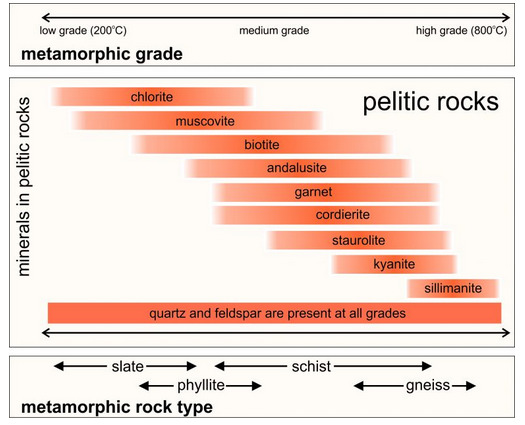
The chart in Figure 8.42 shows typical minerals in metapelites at different grades. Quartz and Na-rich plagioclase are in rocks of all grades. Kaolinite, pyrophyllite and chloritoid may also be present at low grade but are less common and are omitted from this figure. There is a great deal of overlap and many of these minerals exist together. Some persist over a wide range of temperatures. Some are present in low-pressure rocks but not in high-pressure rocks. Either muscovite or biotite are generally present except at the highest grades.
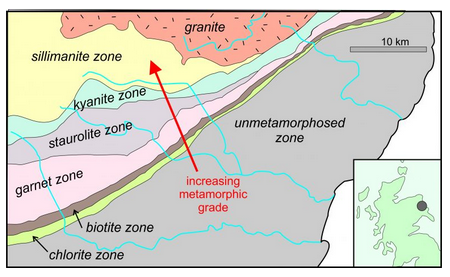
The most classic example of regionally metamorphosed pelites is in the Scottish Highlands where, in the late 19th and early 20th centuries, George Barrow mapped a large region of variable metamorphic grade. The map seen in Figure 8.43 derives from Barrow’s work. In this region, metamorphic grade increases from southeast to northwest. Barrow recognized that the higher-grade metamorphic rocks he was mapping were once unmetamorphosed shales. He mapped different metamorphic zones based on the metamorphic minerals that were present. Each of Barrow’s zones is characterized by a particular index mineral that reflects metamorphic grade. Thus, the zone names in this map.
Rocks similar to the ones described by Barrow, are found worldwide. They are said to be the results of Barrovian metamorphism, a tribute to Barrow. In North America, Barrovian metamorphism is particularly well exposed and studied in the Appalachian Mountains and in the Canadian Shield. Most metapelites in Scotland experienced Barrovian metamorphism, but in an area just north of Aberdeen, metamorphism occurred at slightly lower pressures than classic Barrovian metamorphism. We call this kind of metamorphism Buchan metamorphism, named after the Buchan region where it is found. Besides Scotland, other classic occurrences are in Japan and Spain, but Buchan terranes are found worldwide. Metamorphic rocks in these areas may contain cordierite and andalusite, two low-pressure minerals commonly absent from Barrovian terranes.
The photos below show typical medium-grade metapelites. Figure 8.44 contains garnet porphyroblasts and Figure 8.45 contains staurolite porphyroblasts. The porphyroblasts in both photos are centimeters across. Muscovite surrounds them. Figure 8.46 contains conspicuous blades of blue kyanite surrounded by quartz, some of which is stained reddish by hematite. Figure 8.47 contains centimeter-sized crystals of blue cordierite. Cordierite can be difficult to identify unless it has this diagnostic blue bottle glass appearance. Figures 8.23 and 8.28, earlier in this chapter, also show examples of typical medium-grade metapelites.
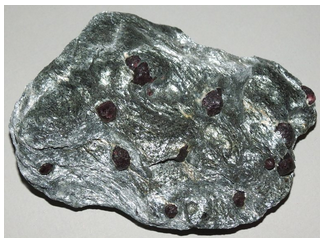
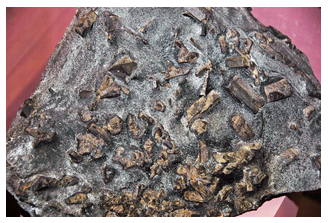
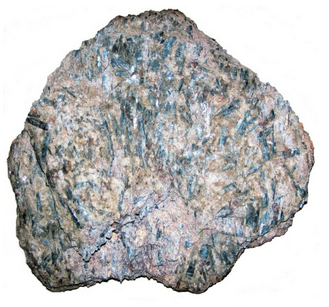
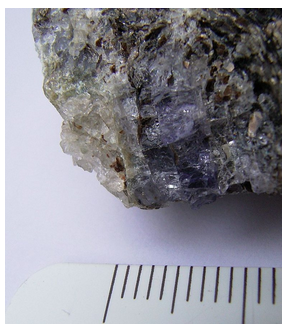

Figure 8.48 shows pressure-temperature stability fields for common pelitic mineral assemblages. Besides the minerals listed, quartz and plagioclase are present under all conditions. The bounding white lines are really diffuse boundaries and the reactions that relate one assemblage to another are complex.
Many metapelitic rocks contain an Al2SiO5 polymorph (andalusite, kyanite, or sillimanite) besides the mineral listed. Red lines and text in this phase diagram show the stability fields for the different polymorphs: kyanite at high pressure, sillimanite at high temperature, and andalusite at low pressure. At medium- or high-grade, Barrovian metamorphism often yields rocks containing kyanite or sillimanite with garnet. At lower pressures, Buchan metamorphism may produce rocks with andalusite, and often cordierite instead of garnet. Muscovite is generally absent at the highest temperatures because it dehydrates to K-feldspar, sillimanite, and water vapor (at temperatures above the blue dashed line). Note that the order of minerals with increasing metamorphic grade in this phase diagram, and in Figure 8.42, matches the order of metamorphic zones mapped by Barrow in Scotland (Figure 8.43).


